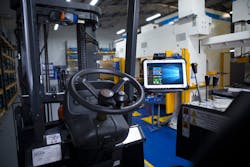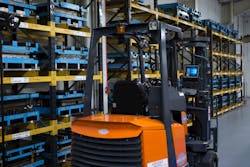How Mobile Devices Help Manufacturers Get Ahead in the Digital Age
For deep rooted industries like manufacturing, adopting new ways of working can be a challenge. Workers are widely accustomed to using legacy processes and systems on the factory floor and in the warehouse, such as clipboards and two-way radios. But in today’s digitally-driven business environment, outdated tools can’t provide the level of efficiency needed to remain competitive. In the manufacturing world, productivity is measured in seconds, so workers need the ability to analyze information in real-time and solve critical challenges at a moment’s notice.
When speaking with our customers, the top need for manufacturers has remained consistent over time—speed of decision-making is essential to success. And, as manufacturing operations management continues to become increasingly more digital, the need for mobile technologies is apparent. Today, we’re seeing new solutions come to market designed specifically with the needs of manufacturers in mind, equipped with capabilities such as integrated barcode scanners, dimensioning and thermal imaging cameras, and multi-mode mobile connectivity for instant data capture and sharing. Using purpose-built, rugged mobile devices, manufacturers can increase efficiency, maximize output and sharpen their competitive edge in three main areas that are critical to organizational success.
Manufacturing facility employees optimizing data entry with mobile technology.
Inventory Management and Quality Control
Every day, manufacturing organizations receive numerous shipments of raw materials that need to be processed before they can be used. These materials must be logged in and tracked for auditing purposes, billing, and regulatory and compliance purposes before putting them into stock. Most often, this is done through barcode scanners, but with new IoT sensor labels, more adaptable and powerful mobile devices that can read both types of labels are being deployed.
When it comes to quality control (QC), one of the most important aspects is to assess the quality of these raw materials, and share that information with the entire organization, especially if there are issues. Similarly, manufacturers also have QC teams to diligently check products that come off the production line and analyze data sets to ensure that the quality is within conformity.
According to a survey of manufacturers, more than 90% believe that product quality defines their success in the eyes of their customers. Anytime quality levels drop or output goals decline, key stakeholders in the organization need to know as soon as possible to mitigate the problem. The sooner those decisions can be made, the sooner the production process can be refined, therefore eliminating the cause of production quality issues. Mobile devices with cameras for thermal imaging or dimensioning can be used by QC to record this data faster, from anywhere in the production process and shared with the entire organization in real-time. If a worker uses a clipboard to record data, those top-level decisions happen much slower, and more faulty items are produced as a result.
Detachable, forklift-mounted mobile devices gives employees the option to work on the go, anywhere in the facility.
Predictive Maintenance
More advanced machinery and technology are being used in the factory than ever before, and as a result, predictive maintenance has become a significant need. It’s critical that automation tools and robotic components on the assembly line function optimally in order to reduce costs and meet target outcomes. For manufacturers, machine glitches can be incredibly expensive if they impact scheduled product deliveries to customers or waste raw materials. In fact, data shows that maintenance management typically takes up at least 40% of a business’s total operational budget.
To combat this, manufacturers are focusing on predictive maintenance, which can identify potential issues before they become a reality. Using a rugged mobile tablet configured with a serial port, an integrated barcode scanner or thermal imaging camera, workers can run diagnostics, assess how a machine is performing, and make necessary fixes. The data collected by the device can then be shared through a dashboard with line supervisors or operations managers, who can make real-time decisions about fixing or replacing faulty equipment.
With the right mobile device in hand, workers can capture, share, and respond to maintenance data in a way that can dramatically impact the quality of the end product and the overall productivity of the organization. In addition, this information can then be fed into analytics databases to be utilized for predicting future maintenance at the optimal time, not too early or too late.
Detachable, forklift-mounted mobile devices gives employees the option to work on the go, anywhere in the facility.
Operational Efficiency
For manufacturers, the name of the game is always efficiency, as it relates to workers, products, and technologies. The ability to share data instantly across an entire organization—from the very bottom to the very top—is critical in order to move quickly in an already fast-paced environment. Digitization is affecting nearly every position in the factory or warehouse, and it is prompting organizations to evaluate how they are using technology to get ahead.
One of the biggest shifts we’re seeing in the manufacturing industry today is the move away from single-use, hard-mounted devices, to multi-purpose mobile devices that can be adapted for use in multiple areas of the plant. In a modern facility, devices are commonly used in only one area, such as a laptop mounted to a forklift and a tablet fixed to the end of a production line.
Hard-mounted devices do not allow workers and managers the flexibility to take along and access critical information wherever they are in the plant, which is essential to real-time data sharing and fast decision making. Of course, the devices used must be able to withstand the rough handling, bumping, and drops that are inevitable in a plant or warehouse environment.
We’re also seeing manufacturing organizations take this trend one step further, by transitioning their devices to a single hardware provider. Using a uniform family of purpose-built devices allows for more streamlined training for end-users and easier device management and maintenance for IT. It also means that technical and engineering support comes from a single source, allowing for faster and more efficient troubleshooting.
Form Factor Flexibility
A recent survey of manufacturers found that more than 40% of organizational leaders believe that mobile technology will contribute the most business value over the next three years. And the benefits of mobile devices will span far beyond workers on the assembly line, demanding devices for numerous, varying operations. Manufacturers are integrating these mobile ecosystems across the enterprise with handheld devices used for inventory management to forklift-mounted tablets used for swift data entry on the shipping dock and then used by receiving for proof of delivery. The best selection of a mobile device platform for manufacturing will offer the flexibility to support varying applications and the endurance for manufacturing operations.
To make the transition from a clipboard culture to a mobile environment outfitted with the optimal device deployment, manufacturers should find a trusted partner that understands their business needs and can provide devices configured for their work. It’s equally important to work with a technology partner that can offer a total package of hardware, software, and tailored solutions, which can evolve alongside the company.
In an industry where things are constantly changing, and new innovations are around every corner, it’s critical that manufacturers remain one step ahead. To improve the speed and efficiency needed to drive profits, workers must be equipped with adaptable devices that are designed and purpose-built to quickly and accurately capture and share critical data and reliably connect and communicate with people and systems across the entire organization. Manufacturers can no longer afford to rely on outdated technology and processes that leave room for human error and quality issues. By investing in mobile solutions purpose-built for the needs of manufacturers today, organizations can improve efficiency and optimize resources to remain competitive and meet key business goals.
Jay Voorheis is national sales manager for Panasonic Toughbook Mobile Solutions.




